Abstarct
The current study aims at reviewing and providing advances on methods for estimating and applying crop coefficients from observations of ground cover and vegetation height. The review first focuses on the relationships between single Kc and basal Kcb and various parameters including the fraction of ground covered by the canopy (fc), the leaf area index (LAI), the fraction of ground shaded by the canopy (fshad), the fraction of intercepted light (flight) and intercepted photosynthetic active radiation (fIPAR). These relationships were first studied in the 1970’s, for annual crops, and later, in the last decennia, for tree and vine perennials. Research has now provided a variety of methods to observe and measure fc and height (h) using both ground and remote sensing tools, which has favored the further development of Kc related functions. In the past, these relationships were not used predictively but to support the understanding of dynamics of Kc and Kcb in relation to the processes of evapotranspiration or transpiration, inclusive of the role of soil evaporation. Later, the approach proposed by Allen and Pereira (2009), the A&P approach, used fc and height (h) or LAI data to define a crop density coefficient that was used to directly estimate Kc and Kcb values for a variety of annual and perennial crops in both research and practice. It is opportune to review the A&P method in the context of a variety of studies that have derived Kc and Kcb values from field measured data with simultaneously observed ground cover fc and height. Applications used to test the approach include various tree and vine crops (olive, pear, and lemon orchards and vineyards), vegetable crops (pea, onion and tomato crops), field crops (barley, wheat, maize, sunflower, canola, cotton and soybean crops), as well as a grassland and a Bermudagrass pasture. Comparisons of Kcb values computed with the A&P method produced regression coefficients close to 1.0 and coefficients of determination ≥ 0.90, except for orchards. Results indicate that the A&P approach can produce estimates of potential Kcb, using vegetation characteristics alone, within reasonable or acceptable error, and are useful for refining Kcb for conditions of plant spacing, size and density that differ from standard values. The comparisons provide parameters appropriate to applications for the tested crops. In addition, the A&P approach was applied with remotely sensed fc data for a variety of crops in California using the Satellite Irrigation Management Support (SIMS) framework. Daily SIMS crop ET (ETc-SIMS) produced Kcb values using the FAO56 and A&P approaches. Combination of satellite derived fc and Kcb values with ETo data from Spatial CIMIS (California Irrigation Management Information System) produced ET estimates that were compared with daily actual crop ET derived from energy balance calculations from micrometeorological instrumentation (ETc EB).Results produced coefficients of regression of 1.05 for field crops and 1.08 for woody crops, and R2 values of 0.81 and 0.91, respectively. These values suggest that daily ETc-SIMS -based ET can be accurately estimated within reasonable error and that the A&P approach is appropriate to support that estimation. It is likely that accuracy can be improved via progress in remote sensing determination of fc. Tabulated Kcb results and calculation parameters are presented in a companion paper in this Special Issue.
Link to the article: click here
ABSTRACT
This study reviews the abundant research on FAO56 crop coefficients, published following introduction of the FAO56 paper in 1998. The primary goal was to evaluate, update, and consolidate the mid-season and end-season single (Kc) and basal (Kcb) crop coefficients, tabulated for many field crops in FAO56. The review found that the prevalent approach for estimating crop evapotranspiration (ETc) is the FAO56 Kc-ETo approach, i.e., the product of the Kc and reference evapotranspiration (ETo). The FAO56 Kc-ETo approach requires use of the FAO56 PM-ETo grass reference equation with appropriate crop-specific Kc and/or Kcb. Reviewed research provided various approaches to determine Kc and Kcb and used a variety of actual crop ET (ETc act) measurements. Significant attention was placed on accessing the accuracy of the field measurements and models used in these studies. Accuracy requirements, upper limits for Kc values, and related causal errors are discussed. Conceptual approaches relative to Kc transferability requirements are provided with focus on standard crop conditions and use of the FAO56 segmented Kc curve. Papers selected to update Kc∕Kcb used the FAO56 PM-ETo, provided accurate measurements to determine and partition ETc act, and satisfied transferability requirements. Selected observed Kc and Kcb values were converted to standard, sub-humid climate as adopted in FAO56. Observed values, with respect to tabulated FAO56 Kc and Kcb, were used in consolidating updated values for crops within general categories of grain legumes, fiber crops, oil crops, sugar crops, small grain cereals, maize and sorghum, and rice. Ancillary data, e.g., maximum root depth and crop height, were also collected from selected literature and tabulated. Results showed good agreement between updated and original tabulated FAO56 Kc and Kcb, confirming the reliability of the FAO56 values. This indicates change in the Kc (ETc/ETo ratio) of crops has not occurred due to climate change during the past ≈sixty years. New Kc∕Kcb data for crops, not included in FAO56, are also now presented for several oil crops and pseudo-cereals. The approach adopted for rice differs from FAO56 because consideration was given to the numerous rice water management practices currently used and, thus, Kc∕Kcb values for the initial season of rice were also presented. The review also observed that many research papers did not satisfy the adopted requirements in terms of ETo method and/or the accuracy of ETc act determinations and, therefore, could not be used. Thus, emphasis is placed on adopting improved accuracy and quality control in future research aimed at determining Kc data comparable to presented values. The transferability of standard Kc and Kcb has been assured for the values tabulated herein. Improved future applications of the FAO56 Kc-ETo method should consider remote sensing observations when available, particularly in defining crop growth stages at given locations
Link to the article: Click here
Abstract
Many research papers on crop water requirements of vegetables have been produced since the publication of the FAO56 guidelines in 1998. A review of this literature has shown that determination of crop evapotranspiration (ETc) using the Kc-ETo approach, i.e., the product of the specific crop coefficient (Kc) by the reference evapotranspiration (ETo), is the most widely-used method for irrigation water management. Consequently, a review was made to provide updated information on the Kc values for these crops. The reviewed research provided various approaches to determine Kc in its single and dual versions. With this purpose, actual crop ET (ETc act) was determined with lysimeters, or by performing the soil water balance using measured soil water content and computational models, or by using Bowen ratio energy balance and eddy covariance measurements, or by using remote sensing applications. When determining the basal Kc (Kcb), the partitioning of ETc act was evaluated using different approaches, though mainly using the FAO56 dual Kc method. Since the accuracy of experimentally-determined Kc and Kcb values depends upon the procedure used to compute ETo, as well as accuracy in determining and partitioning of ETc act, the adequacy of the measurement requirements for each approach was carefully reviewed. The article discusses in detail the conceptual methodology relative to crop coefficients and the requirements for transferability, namely distinguishing between actual and standard Kc and the need to appropriately use the FAO segmented Kc curve. Hence, the research papers selected to update and consolidate mid-season and end-season standard Kc and Kcb were those that computed ETo with the FAO56 PM-ETo equation; and that also used accurate approaches to determine and partition ETc act for pristine, non-stressed cropping conditions. Under these experimental conditions, the reported Kc and Kcb values relative to the mid- and end-season could be considered as transferable standard Kc and/or Kcb values after adjustment to the standard climate adopted in FAO56, where average RHmin = 45% and average u2=2 m s−1 over the mid-season and late season growth stages. For each vegetable crop, these standard values were then compared with the FAO56 tabulated Kc and Kcb values to define the updated values tabulated in the current article. In addition, reported ancillary data, such as maximum root zone depth, maximum crop height, and soil water depletion fraction for no water stress, were also collected from selected papers and tabulated in comparison with those given for the crops in FAO56. The presentation of updated crop coefficient results is performed by grouping the vegetables differently than in FAO56, where distinction is made according to their edible parts: (1) roots, tubers, bulbs and stem vegetables; (2) leaves and flowers vegetables; (3) fruit and pod vegetables; and (4) herbs, spices and special crops, with most of them being newly introduced herein. The updated Kc and Kcb of vegetable crops based on this review are generally coincident with those in FAO56, although slightly lower for several crops. Close agreement of selected paper values with FAO56 values provides good evidence of their quality and also confirms the reliability of the original FAO56 tabulated values. It is noteworthy that many papers surveyed from the past 20 years did not satisfy the adopted Kc requirements in terms of ETo computation method nor provide solid evidence of measurement accuracy for ETc act. It is recommended that future Kc research of vegetables should sufficiently address these issues with objectives broadened to provide more transferable data to other regions. Also, new data on vegetable Kc and Kcb values should be carefully scrutinized in the context of these results and those provided in FAO56.
Link to the article : Click here
The current deliverable contains the structure of the Web-based information platform (WBIP), elibrary and networking for knowledge management and active information flow. The web-based platform is part of the WP1 it helps in the co-ordination and monitoring of the partners activities, and knowledge exchange between partners and stakeholders.
The objective is to develop the website of SUPROMED project using a content management system for easy updating by the project partners. The website will be used to:
• Disseminate information on the project implementation and results to the different stakeholders from various Mediterranean countries and beyond
• Actively engage the stakeholders in some activities (e.g. workshops) and future use of the SUPROMED solutions
A separate online tool will be set up for collaborative working between the partners and sharing documents with advisory board members and PRIMA foundation. The website is first developed in English, the other projects languages (Arabic, French and Spanish) will be added with the support of partners for the translation. The website must be responsive web design (i.e. accessible from a PC, a tablet or a smartphone) and ready to operate on the secure communication protocol HTTPS.

